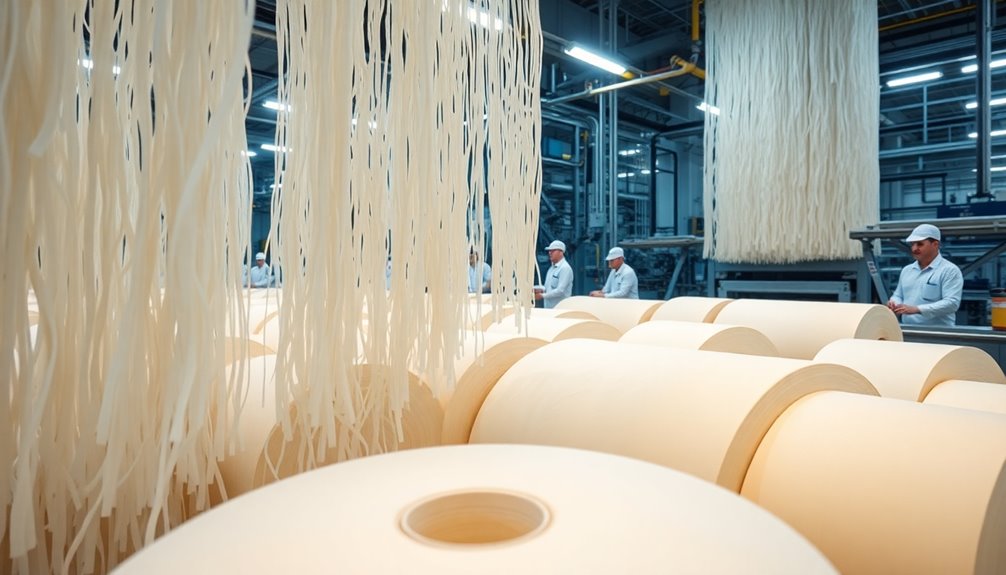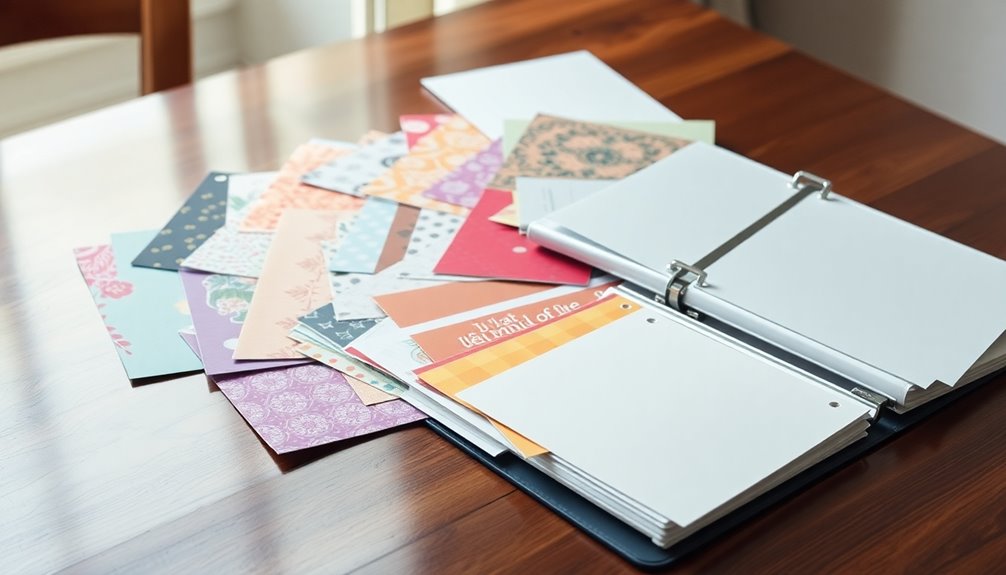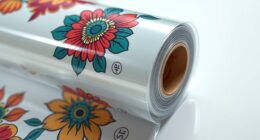Tissue paper's made through a precise process that starts with pulping raw materials, like wood fibers or recycled paper, which creates a slurry. This slurry gets pressed to remove water and then dried using heated cylinders, ensuring the right thickness and softness. The dried paper is embossed for added texture and then cut into the desired dimensions. Finally, it's packaged for sale. The quality depends on materials used, whether virgin or recycled. If you're curious about the varieties of tissue paper and their specific uses, there's much more to uncover beyond just the manufacturing process.
Key Takeaways
- Tissue paper production begins with pulping, where wood fibers or recycled materials are blended with water and chemicals to create a slurry.
- The wet fiber mat is pressed to remove excess water, compacting the fibers for desired thickness.
- Drying follows, using heated cylinders to control moisture content and enhance softness.
- Embossing adds decorative patterns to increase consumer appeal, while converting cuts tissue into specific dimensions for easy use.
- Finally, tissue is packaged into rolls or sheets, undergoing quality control to ensure thickness and absorbency meet industry standards.
Types of Tissue Paper
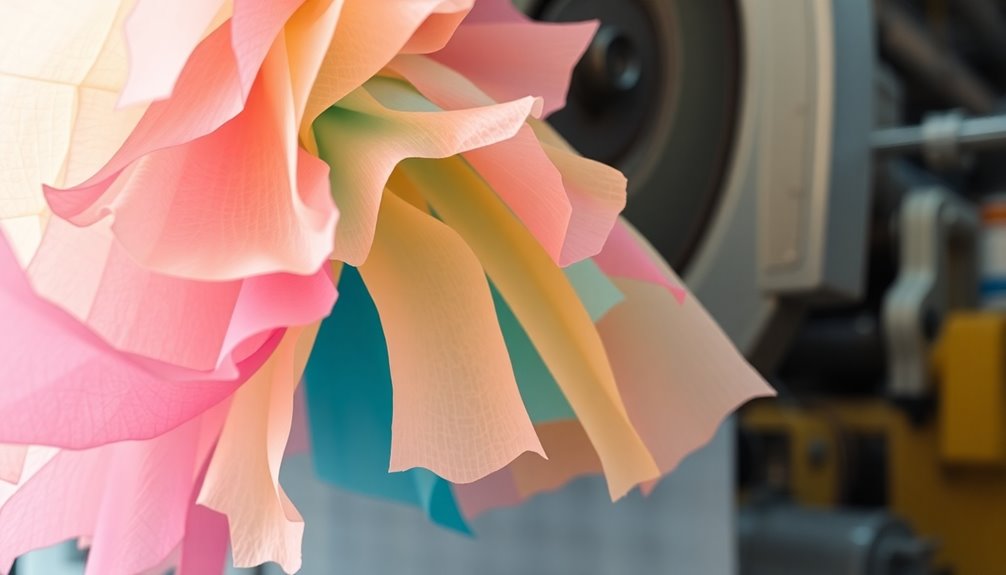
When it comes to tissue paper, you'll find a variety of types tailored for different needs. Each type serves a unique purpose, ensuring you have the right product for every situation.
Facial tissues are often your go-to for personal hygiene; they're softer and more absorbent, perfect for keeping your face clean and comfortable.
In the bathroom, toilet paper is essential for personal hygiene, designed to be gentle yet effective.
Meanwhile, in kitchens, you'll likely reach for paper towels, which are thicker and more absorbent, ideal for cleaning up spills and messes.
When you're dining, napkins come into play, providing a handy way to wipe your hands and clean up any accidental spills. You'll find them in both disposable and reusable forms, making them versatile for any occasion.
Finally, wrapping tissue adds a decorative touch to gifts, serving an aesthetic purpose while keeping your presents looking great.
With all these options, you can easily choose the right type of tissue paper for your needs, whether for hygienic products or special occasions.
Manufacturing Processes
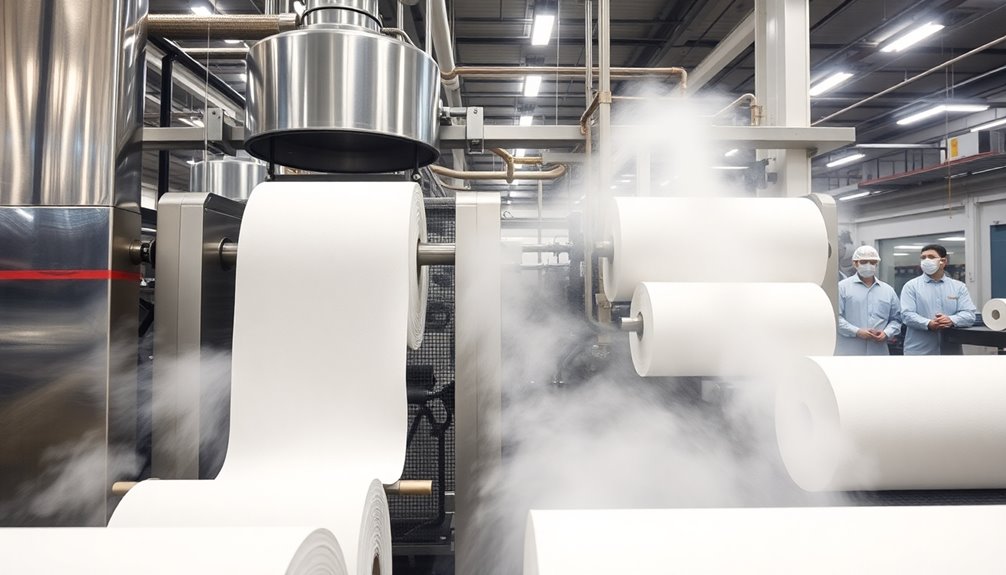
The intricate process of manufacturing tissue paper combines precision and innovation to create a product that meets diverse consumer needs. It starts with pulping, where you mix wood fibers or recycled materials with water and chemicals to form a slurry. This slurry is then processed to produce high-quality paper pulp, laying the foundation for your tissue paper.
Next, during pressing, the wet fiber mat is squeezed to remove excess water and compact the fibers. This step is critical for achieving the desired thickness and softness.
After pressing, you move on to drying, where heated cylinders help to achieve the perfect moisture content. This guarantees your tissue paper isn't only soft but also durable.
Finally, the converting stage involves cutting the dried tissue into specific dimensions, embossing it for added texture, and packaging it into rolls or sheets for distribution.
Throughout the entire manufacturing process, quality control is essential. You'll need to make adjustments to roller speeds and drying conditions to influence the thickness and absorbency, guaranteeing that the final product meets the high standards consumers expect.
Raw Materials Used
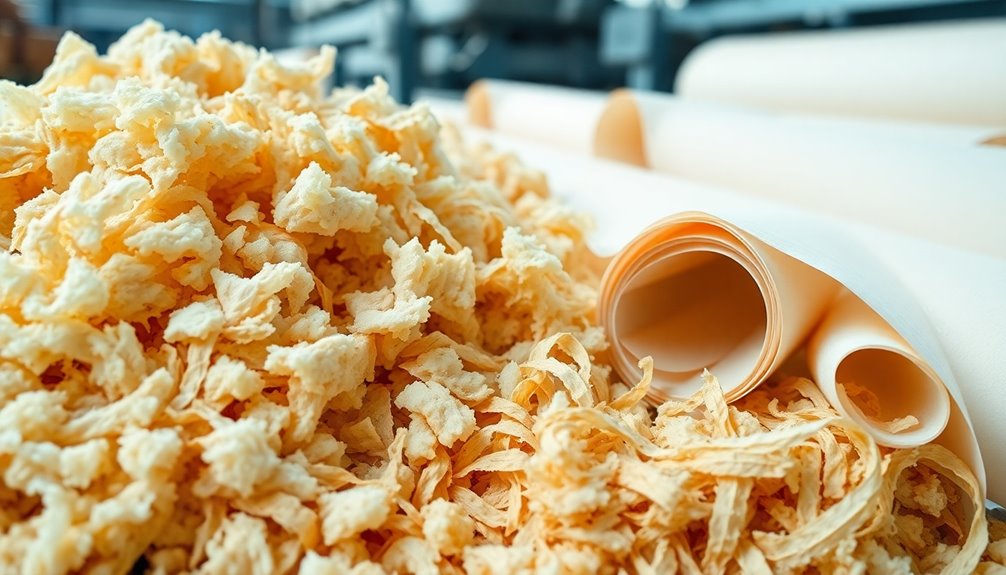
Tissue paper primarily relies on two key raw materials: virgin pulp and recycled pulp. Virgin pulp consists of fresh wood fibers, offering superior softness and absorbency, making it perfect for high-end tissue products. On the other hand, recycled pulp comes from previously used paper products, providing a more eco-friendly alternative.
Balancing quality and environmental considerations is essential in tissue paper manufacturing. Here's a quick comparison of the two types of raw materials:
| Type of Pulp | Characteristics |
|---|---|
| Virgin Pulp | Made from fresh wood fibers, high-quality softness. |
| Recycled Pulp | Derived from recovered fibers, eco-friendly option. |
| Quality Impact | Influences softness and absorbency levels. |
| Sustainable Sourcing | Critical for both types to minimize environmental impact. |
| Industry Use | Virgin for premium products, recycled for everyday use. |
As the tissue paper industry evolves, sustainable sourcing practices are becoming increasingly important. By understanding the role of these raw materials, you can appreciate the balance between maintaining quality and supporting eco-friendly initiatives.
Steps in Production

When you look at how tissue paper is made, the journey starts with the pulping process.
You'll see wood fibers or recycled materials mixed with water and chemicals, creating a slurry that sets the stage for the next steps.
From there, the production continues through drying and converting techniques to shape the final product.
Pulping Process Overview
In the pulping process for tissue paper production, logging trees are first transformed into small chips and then ground into flakes. These flakes are soaked and retted in a mixer tank, where you combine them with water and chemical treatment, including sodium sulphide and limestone.
This step is vital, as it transforms hardwood into soft fiber material, which is essential for achieving the desired softness and absorbency in the final tissue paper product.
Once the flakes have undergone chemical treatment, the resulting wood pulp is refined to improve fiber bonding, ensuring a high-quality end product. During this refining process, it's important to screen out any contaminants that could compromise the integrity of the tissue.
You'll also focus on balancing the use of virgin and recycled paper pulp to enhance sustainability without sacrificing quality.
Ultimately, the efficiency of the pulping process greatly influences the quality of the final tissue paper. By paying close attention to each step, you can create a product that meets consumer demands for softness and absorbency while promoting environmental responsibility.
Drying and Converting Techniques
Utilizing advanced drying techniques, the wet pulp is moved to a Yankee dryer where heated air evaporates any remaining moisture, transforming it into a thin sheet of tissue paper. The speed at which the pulp travels through the drying cylinder is carefully adjusted to control both the thickness and softness of the final product. This precision guarantees that the tissue meets quality standards.
Once the drying process is complete, the tissue paper is passed through an embossing roller. This step not only creates decorative patterns but also enhances the softness, making the paper more appealing to consumers. The embossed texture adds a touch of elegance and functionality.
In the converting stage, multiple plies of tissue are glued together and perforated, allowing for easy separation. This feature is essential for consumer convenience, as it enables you to tear off exactly what you need without hassle.
Finally, the completed tissue paper is shaped into various sizes of rolls or flat sheets. Once packaged in bundles, the final product is ready for distribution and sale, guaranteeing that you can find it easily when you need it.
Properties of Tissue Paper
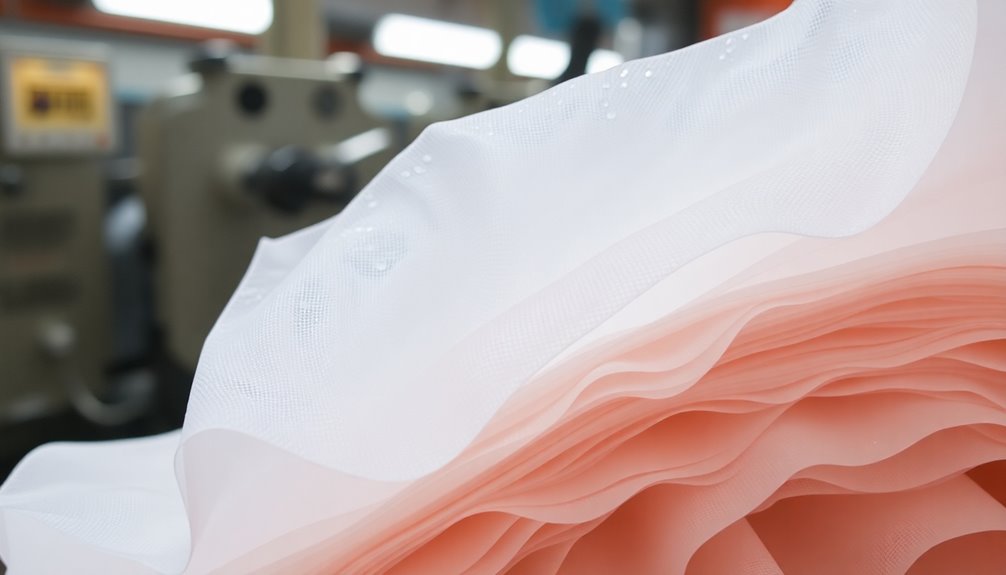
When you think about tissue paper, its absorbency and strength are key features that make it so effective for everyday use.
The basis weight, which typically ranges from 10 to 35 grams per square meter, also plays a vital role in determining how durable the paper will be.
Additionally, thickness affects not just the feel but also the overall performance, ensuring comfort and functionality in various applications.
Absorbency and Strength
Achieving the right balance of absorbency and strength is vital for tissue paper, especially for its hygienic applications. High absorbency levels are often achieved through manufacturing processes like the Through-Air-Dried (TAD) method. The basis weight of tissue paper, typically ranging from 10 to 35 GSM, plays an important role in its strength and durability. Heavier weights usually correlate with increased absorbent capacity, ensuring that the tissue paper performs effectively.
The incorporation of additives during the manufacturing process can greatly enhance both absorbency and strength. These additives help tailor the tissue paper for various uses, such as paper towels and napkins. Additionally, the creping process helps improve softness while maintaining structural integrity, allowing the paper to absorb liquids without disintegrating quickly.
| Property | Description | Impact on Use |
|---|---|---|
| Absorbency | Ability to soak up liquids | Essential for hygiene |
| Strength | Resistance to tearing when wet | Enhances durability |
| Additives | Chemicals added for improved performance | Customizes properties |
Basis Weight Characteristics
The characteristics of basis weight in tissue paper play a pivotal role in determining its overall performance and suitability for various uses. Basis weight, measured in grams per square meter (GSM), typically ranges from 10 to 35 GSM for tissue products. This measurement greatly influences absorbency and durability.
For instance, lighter tissue papers with a lower GSM are generally less absorbent, while those with a higher GSM offer greater strength and absorbency. Standard facial tissues usually fall within the 15-20 GSM range, making them soft and suitable for everyday use.
On the other hand, paper towels, which often range from 20-24 GSM, provide enhanced absorbency and durability. The basis weight also directly affects the softness of the tissue. Higher basis weight allows for more fiber, improving the overall feel of the product.
Variations in basis weight across different tissue products, such as toilet paper and napkins, enable manufacturers to target specific applications. By balancing cost and performance, they cater to consumer needs effectively.
Understanding these basis weight characteristics helps you choose the right tissue product for your particular requirements.
Thickness and Comfort
Thickness and comfort are essential factors that can greatly enhance your experience with tissue paper. The thickness of tissue paper is measured in Grams per Square Metre (GSM), typically ranging from 10 to 35 GSM. Thinner papers, with lower GSM, may not provide the same level of absorbency and comfort as thicker options. When you choose thicker tissue paper, you're likely to enjoy better moisture retention, which is critical for hygienic applications.
The comfort of tissue paper is considerably influenced by its softness, achieved through the careful manipulation of pulp during the manufacturing process. Techniques like refining and creping help guarantee the final product feels pleasant against your skin.
Additionally, the basis weight of the tissue paper affects its strength and durability, playing an important role in your overall comfort during use, especially for products like facial tissues and paper towels.
Manufacturers can customize tissue paper's thickness and comfort by adjusting the speed of rollers and selecting specific types of pulp. This adaptability guarantees that you can find the perfect tissue paper to meet your specific needs and preferences, enhancing your overall experience.
Applications and Uses
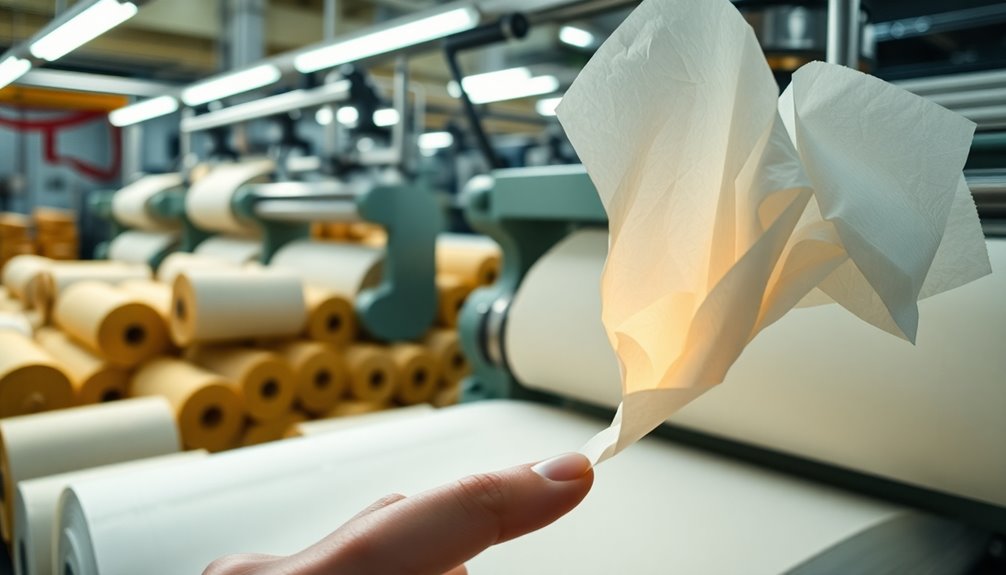
Tissue paper's versatility makes it an essential component in various aspects of daily life. You'll find it in multiple forms, each designed for specific uses. Here are three key applications:
- Hygiene Products: Tissue paper is widely used for hygiene purposes, including toilet paper, facial tissues, and paper towels. In Western Europe alone, over 20 billion rolls of toilet paper are consumed annually.
- Dining Essentials: Tissue paper napkins enhance dining experiences by providing a convenient, disposable option for cleanliness, making them a staple in restaurants and households.
- Creative Uses: This paper is also popular in arts and crafts, such as origami and gift wrapping, where various types of tissue paper available in a range of colors allow for creative expression.
Moreover, the absorbency and softness of kitchen towels, a heavier type of tissue paper, are vital for cleaning tasks, helping maintain hygiene in homes and restaurants.
Additionally, tissue manufacturing has led to specialized applications, like using tissue paper as acoustic disrupters in sound engineering to improve sound quality.
Environmental Impact
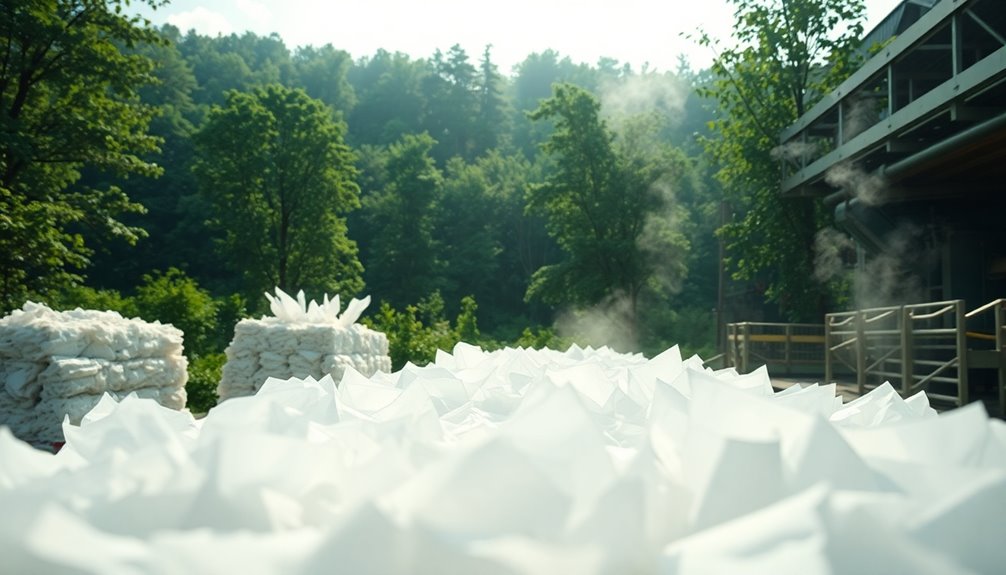
Environmental concerns surrounding tissue paper production are significant and multifaceted. You might be surprised to learn that about 270,000 trees are flushed daily, primarily for toilet paper, contributing to deforestation. However, there's a shift happening.
Here's a quick overview of the sustainability efforts in the paper industry:
| Aspect | Traditional Manufacturing | Recycled Fiber Usage |
|---|---|---|
| Raw Material Source | Freshly cut trees | Recovered fibers |
| Deforestation Impact | High | Lower |
| Carbon Emissions | Higher | Ongoing reduction efforts |
| Eco-labeling Initiatives | Limited | Expanding |
The paper industry currently sources approximately 46.5% of its materials from recovered fibers, reflecting a growing awareness of sustainability. Life-cycle assessments reveal that both new and recycled fibers have their pros and cons, leading to efforts aimed at reducing carbon emissions by 25%. Initiatives like the German Blue Angel program promote eco-friendly manufacturing practices, emphasizing the importance of reducing the environmental impact of tissue paper. As you consider your tissue paper choices, remember that opting for recycled products can contribute to a more sustainable future.
Industry Trends and Innovations

A remarkable shift is underway in the tissue paper industry, driven by rising demand for hygiene products and a commitment to sustainability.
As you explore this evolving landscape, here are three key trends to note:
- Sustainable Sourcing: Nearly 46.5% of raw materials used in tissue production now come from recycled paper, greatly reducing environmental impact.
- Innovative Manufacturing Techniques: The Tissue Paper Manufacturing Process is being revolutionized through advanced materials and the adoption of the Through-Air-Dried (TAD) process, which enhances absorbency despite its higher energy consumption.
- Collaborative Efforts: Manufacturers are increasingly partnering to develop eco-friendly tissue products, showcasing a collective commitment to sustainability and reduced carbon emissions.
These innovations not only improve the quality of tissue products but also reflect a broader commitment to environmental stewardship.
As the global tissue paper market is projected to grow at an annual rate of 5.24% from 2024 to 2028, staying informed about these trends will help you appreciate the industry's transformation.
Embracing sustainability and efficiency, the tissue paper sector is
Frequently Asked Questions
How Is Tissue Paper Made Step by Step?
To understand how tissue paper's made, you start with raw materials mixed into a slurry.
Next, you refine the pulp for better fiber bonding and screen it to remove impurities.
Then, you press out excess water, compacting the fibers into a wet mat.
After that, you dry the mat using heated rollers to remove moisture.
Finally, you convert the dried sheet by splitting, embossing, perforating, and rolling it into various sizes for packaging.
What Material Is Tissue Paper Made Of?
Tissue paper is primarily made from paper pulp, which you can find in both virgin wood fibers and recycled materials like cardboard and newspapers.
If you're looking for softness and absorbency, virgin pulp is the way to go. However, if you want something more eco-friendly, recycled pulp is a great option, though it mightn't be as soft.
Many manufacturers blend these materials to balance quality and sustainability, addressing environmental concerns.
What Is the Ingredient of Tissue Paper?
The main ingredients of tissue paper are wood fibers, which come from either virgin pulp or recycled materials.
If you're looking for softness and absorbency, virgin pulp is your best bet, as it's derived from fresh wood.
On the other hand, recycled pulp is a cost-effective, eco-friendly option, though it may be less soft.
Other additives might be included to enhance properties like brightness or antibacterial qualities, making the final product more effective for hygiene use.
What Tree Is Tissue Paper Made From?
When you think about tissue paper, consider the trees involved in its creation.
Tissue paper's primarily made from hardwood trees like eucalyptus and birch, which provide the soft fibers you appreciate. Softwood trees like pine add strength to the mix.
Plus, recycled paper contributes to sustainability, making it an eco-friendly choice.
Conclusion
To summarize, tissue paper plays an essential role in our daily lives, from personal care to household needs. By understanding how it's made, the materials used, and its environmental impact, you can make more informed choices about the products you use. As the industry evolves with new innovations, staying aware of trends can help you support sustainable practices. So, next time you reach for a roll, you'll appreciate the effort behind it and its importance in our world.

